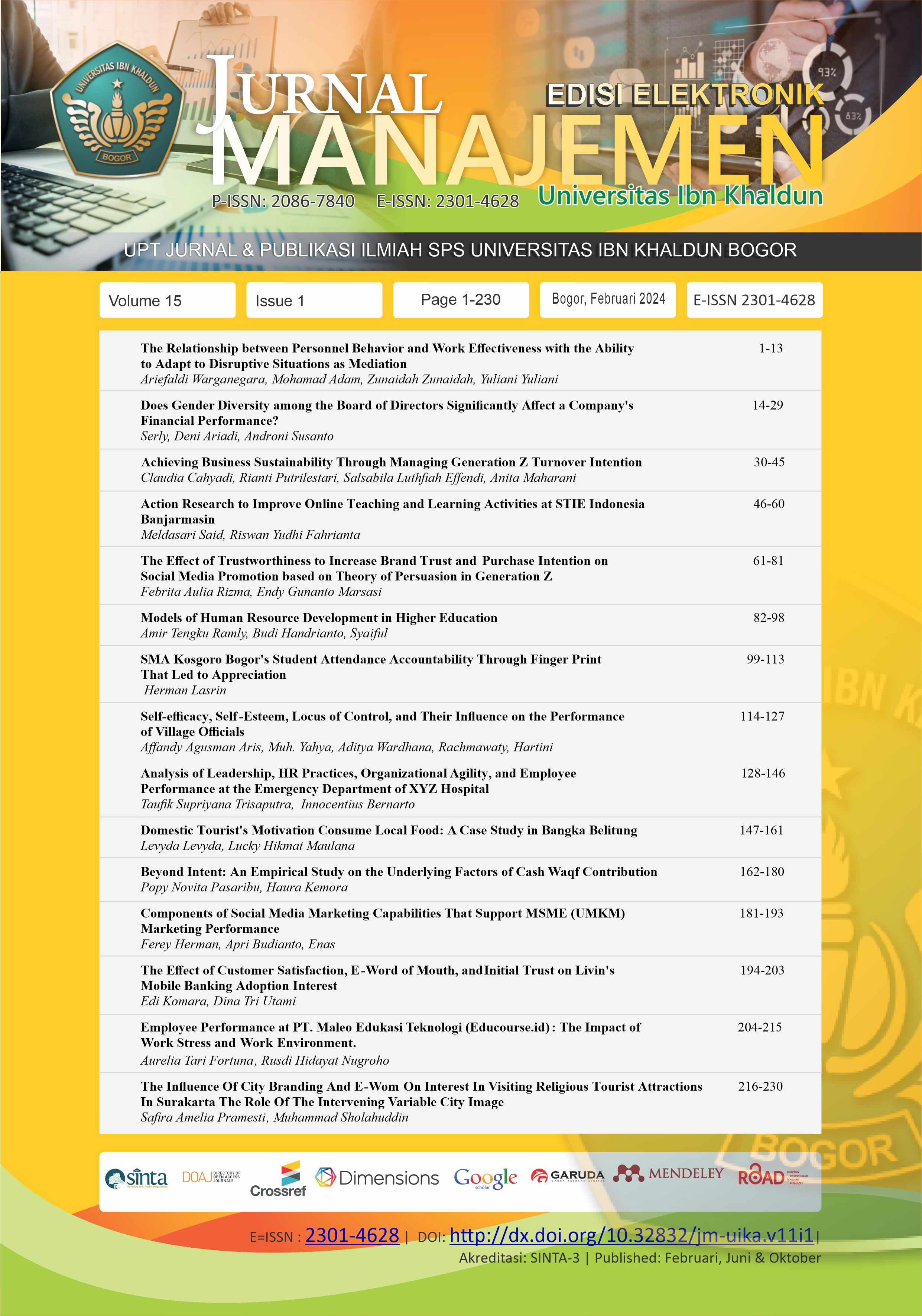Action Research to Improve Online Teaching and Learning Activities at STIE Indonesia Banjarmasin
DOI:
https://doi.org/10.32832/jm-uika.v15i1.15424Keywords:
action research, online learning, synchronous, asynchronousAbstract
This study aims to analyze the readiness STIE Indonesia Banjarmasin students in facing online learning, and what actions are good to take so that learning outcomes can be achieved. This study used action research methods. The method of data collection through observation of three classes with a total of 145 students, complemented by interviews with eight students from representatives of each class as informants. Observations were made in three cycles, namely online synchronous class cycle, the online asynchronous cycle using video, and the online asynchronous cycle using video plus quizzes. Each cycle goes through four stages, namely design, implementation, evaluation, and rethink. The results show that postgraduate students prefer online classes because it saves travel costs and is more flexible in terms of time. They prefer synchronous classes because there is direct interaction. While undergraduate students prefer offline classes so they can focus, avoid a non-conducive learning environment. In addition, for the learning method with video, it is more effective if it is added with a quiz at the end of the material to increase students' access to watching online learning videos.
References
Alawamleh, M., Al-Twait, L. M., & Al-Saht, G. R. (2022). The effect of online learning on communication between instructors and students during Covid-19 pandemic. Asian Education and Development Studies, 11(2), 380–400. https://doi.org/10.1108/AEDS-06-2020-0131
Ambarita, J., & Yuniati, E. (2022). Pelatihan Dan Pendampingan Penulisan Artikel Ilmiah Bagi Guru Dengan Metode Syncronous Dan Asyncronous. Wawasan: Jurnal Kediklatan Balai Diklat Keagamaan Jakarta, 3(1), 64–82. https://doi.org/10.53800/wawasan.v3i1.129
Anderson, T. (2011). The Theory and Practice of Online Learning (2nd ed.). Edmonton: AU Press Athabasca University.
Bennie, A. (2021). Book Review: Conducting Practitioner Research in Physical Education and Youth Sport. Sport, Education and Society, 26(7), 812–814. https://doi.org/https://doi.org/10.1080/13573322.2021.1958529
Bosch, C. (2017). Promoting self-directed learning through the implementation of cooperative learning in a higher education blended learning environment. Potchefstroom Campus of the North-West University.
Carstens, K. J., Mallon, J. M., Bataineh, M., Al-Bataineh, A. (2021). Effects of Technology on Student Learning. TOJET: The Turkish Online Journal of Educational Technology, 20(1), 105–113. Retrieved from https://files.eric.ed.gov/fulltext/EJ1290791.pdf
Dyrek, N., Wikarek, A., Niemiec, M., Owczarek, A. J., Olszanecka-Glinianowicz, M., & Kocełak, P. (2022). The perception of e-learning during the SARS-CoV-2 pandemic by students of medical universities in Poland – a survey-based study. BMC Medical Education, 22(1), 1–9. https://doi.org/10.1186/s12909-022-03600-7
Garrison, D. R., Anderson, T., & Archer, W. (1999). Critical Inquiry in a Text-Based Environment: Computer Conferencing in Higher Education. Internet and Higher Education, 2(2–3), 87–105. https://doi.org/10.1016/S1096-7516(00)00016-6
Khan, S., & Jamil, B. (2022). Challenges in Engaging Students during an Online Health Professions Education Course: An Exploratory, Qualitiative Study. Pakistan Journal of Medical and Health Sciences, 16(5), 1151–1154. https://doi.org/10.53350/pjmhs221651151
Li, Q., Jiang, Q., Liang, J. C., Pan, X., & Zhao, W. (2022). The influence of teaching motivations on student engagement in an online learning environment in China. Australasian Journal of Educational Technology, 38(6), 1–20. https://doi.org/10.14742/ajet.7280
Li, Z. (2022). Influence of Online Learning Behavior and Video Playing Questions on Students’ Learning Effect. International Journal of Emerging Technologies in Learning, 17(2), 223–238. https://doi.org/10.3991/IJET.V17I02.28535
Man, M., Azhan, M. H. N., & Wan Hamzah, W. M. A. F. (2019). Conceptual model for profiling student behavior experience in e-Learning. International Journal of Emerging Technologies in Learning, 14(21), 163–175. https://doi.org/10.3991/ijet.v14i21.10936
Mong, H. H., & Standal, Ø. F. (2022). Teaching health in physical education: An action research project. European Physical Education Review, 28(3), 739–756. https://doi.org/10.1177/1356336X221078319
Ndibalema, P. (2022). Constraints of transition to online distance learning in Higher Education Institutions during COVID-19 in developing countries: A systematic review. E-Learning and Digital Media, 19(6), 595–618. https://doi.org/10.1177/20427530221107510
Picciano, A. G. (2017). Theories and frameworks for online education: Seeking an integrated model. Online Learning Journal, 21(3), 166–190. https://doi.org/10.24059/olj.v21i3.1225
Pranitasari, D., Afifah, N., Prastuti, D., Hermastuti, P., Syamsur, G., & Suryono, D. W. (2023). Self Control, Self Awareness dan Kejenuhan Belajar Pada Perilaku Cyberloafing Mahasiswa dalam Pembelajaran Daring. Media Mahajemen Jasa, 11(1), 56–68.
Rahaded, U., Puspitasari, E., & Hidayati, D. (2020). the Impact of Whatsapp Toward UAD Undergraduate Students’ Behavior in Learning Process. International Journal of Educational Management and Innovation, 1(1), 55. https://doi.org/10.12928/ijemi.v1i1.1515
Rona Mahmudah, S. (2020). Pengaruh Pembelajaran Daring terhadap Psikologis Siswa Terdampak Social Distancing Akibat Covid 19. Jurnal Al-Mau’izhoh, 2(2), 1–14. Retrieved from http://jurnal.unma.ac.id/index.php/am/article/view/2293
Thao, L. Q., Cuong, D. D., Hung, V. M., Vinh, L. T., Nghia, D. T., Hai, D. H., & Nhi, N. N. (2023). Eye Strain Detection During Online Learning. Intelligent Automation and Soft Computing, 35(3), 3517–3530. https://doi.org/10.32604/iasc.2023.031026
Yu-Fong Chang, J., Wang, L. H., Lin, T. C., Cheng, F. C., & Chiang, C. P. (2021). Comparison of learning effectiveness between physical classroom and online learning for dental education during the COVID-19 pandemic. Journal of Dental Sciences, 16(4), 1281–1289. https://doi.org/10.1016/j.jds.2021.07.016
Downloads
Published
How to Cite
Issue
Section
License
Copyright (c) 2024 Jurnal Manajemen (Edisi Elektronik)

This work is licensed under a Creative Commons Attribution-NonCommercial 4.0 International License.
Authors who publish with this journal agree to the following terms:
- Authors retain copyright and grant the journal right of first publication with the work simultaneously licensed under a Creative Commons Attribution-NonCommercial-ShareAlike 4.0 International License that allows others to share the work with an acknowledgement of the work's authorship and initial publication in this journal.
- Authors can enter into separate, additional contractual arrangements for the non-exclusive distribution of the journal's published version of the work (e.g., post it to an institutional repository or publish it in a book), with an acknowledgement of its initial publication in this journal.
- Authors are permitted and encouraged to post their work online (e.g., in institutional repositories or on their website) prior to and during the submission process, as it can lead to productive exchanges, as well as earlier and greater citation of published work (See The Effect of Open Access).











